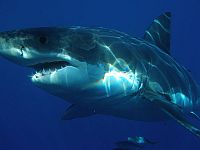 North Pacific humpback whales feed in Alaska but they winter in the Hawaiian Islands, where they mate, calve and nurse their young. The Pacific grey whales do something quite similar, spend their winters in the warm lagoons of Baja, Mexico, having sex and giving birth. Now, shark researchers have located what they believe is a great white shark nursery off the south shore of Long Island.
North Pacific humpback whales feed in Alaska but they winter in the Hawaiian Islands, where they mate, calve and nurse their young. The Pacific grey whales do something quite similar, spend their winters in the warm lagoons of Baja, Mexico, having sex and giving birth. Now, shark researchers have located what they believe is a great white shark nursery off the south shore of Long Island.
Very little has been known about shark breeding and birthing patterns. Unlike whales, where the young migrate with their pods, the young great white sharks are believed to be left by their mothers and spend their first twenty years in the area where they were born. The research group research group Ocearch, led by Chris Fischer, has conducted over two dozen expeditions looking for and tagging great white sharks. Recently, however, the team has found and tagged at least nine great white pups near Montauk, Long Island.
“[This is] definitely the nursery, likely the birthing site,” Fischer told CBS News. “Probably the most important significant discovery we’ve ever made on the ocean.”
Female great whites can have between two and ten pups in a litter. While scientists have never witnessed the birth of a great white shark, the number of juvenile sharks tagged suggests that the area may be a birthing site.
In a press release Tobey Curtis, lead scientist and Fisheries Manager at NOAA Fisheries says, “We’ve learned a lot about the adult sharks in recent years, but the pups are still a complete mystery. Tagging these baby white sharks will help us better understand how essential Long Island waters are for their survival.”
Last January, scientists from WCS’s New York Aquarium discovered a nursery ground for the sand tiger shark in the near shore waters of Long Island’s Great South Bay.

Man that’s really cool. Hopefully it doesn’t lead to a real life Jaws type scenario, but I’m glad to see evidence that these important creatures are thriving in some places.